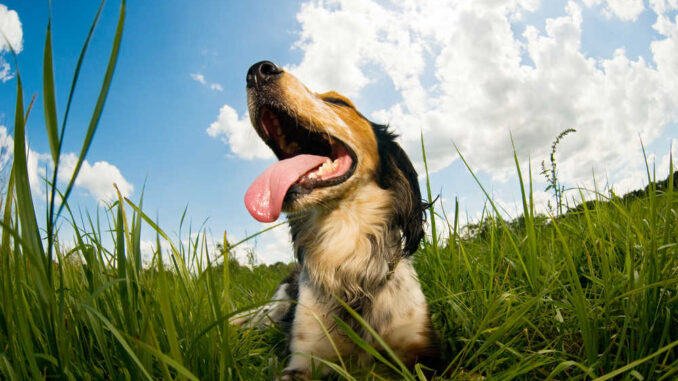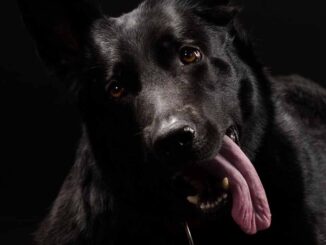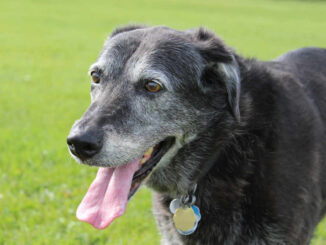
Panting is a natural mechanism dogs use for thermoregulation. It’s a common sight during hot weather or after exercise. However, excessive or unexplained panting can be an indicator of an underlying health issue, which could range from anxiety to more serious conditions like diabetes. If you have a diabetic dog who is suddenly panting more, it’s important to seek veterinary care. Here’s what pet parents should know.
Overview of diabetes in dogs
Diabetes mellitus is a common metabolic condition that affects a dog’s ability to produce or use insulin effectively, and is something we see commonly in the veterinary field. Insulin is a hormone made by the pancreas, and it plays a vital role in regulating blood sugar levels. In a healthy dog, insulin facilitates the uptake of glucose from the bloodstream into cells, where it’s used for energy. In diabetic dogs, lack of insulin causes glucose to accumulate in the blood, leading to hyperglycemia (high blood sugar) and related symptoms:
- Increased thirst and water consumption
- Frequent urination, often in larger quantities than normal
- Unexplained weight loss despite a normal or even increased appetite
- Lethargy or decreased activity
- Cloudy eyes or cataracts
- Urinary tract infections
- Unmanaged diabetes can lead to severe complications such as diabetic ketoacidosis, a life-threatening condition. In addition to the above symptoms of diabetes, these dogs can appear extremely sick with loss of appetite, vomiting, diarrhea, lethargy, weakness, and collapse.
If you suspect your dog might have diabetes, a prompt visit to the veterinarian is crucial. Your vet will likely recommend a series of tests, including blood tests and urinalysis, to confirm the diagnosis. In some cases, more specialized tests may be ordered. Treating diabetes mellitus in dogs generally involves insulin injections in conjunction with diet and lifestyle changes.
Does diabetes cause dogs to pant excessively?
Diabetes itself doesn’t directly cause dogs to pant excessively, but complications or symptoms related to diabetes could contribute to increased panting. You could notice increased panting in your diabetic dog for the following reasons:
- Uncontrolled diabetes or diabetic ketoacidosis – You may notice panting if your dog’s blood sugar is too high or too low, if they are feeling poorly due to complications of diabetes, or if they are dehydrated. In some cases this could indicate a medical emergency.
- Stress, anxiety, or pain associated with chronic illness
- Concurrent diseases – Diabetic dogs may also have other medical conditions, such as Cushing’s Disease or infection, which frequently cause panting.
- Unusual reaction to medication or insulin
It’s crucial to consult a veterinarian for a proper diagnosis and treatment plan if you observe excessive panting alongside other symptoms of diabetes in your dog. Unmanaged diabetes can have severe and life-threatening consequences.
Is panting a reason to be worried for a diabetic dog?
In some cases, heavy panting can indicate a serious or even emergent medical condition. Keeping an eye out for the signs below can help you distinguish abnormal from normal panting in your pup:
- Continuous, relentless panting might be a red flag. This kind of panting does not stop after a short rest period and doesn’t seem to be related to recent physical activity or external temperatures.
- Heavy or strained panting, especially if the dog appears distressed or is having difficulty breathing.
Veterinary care is also needed if panting is accompanied by other worrying signs, such as:
- coughing,
- increased respiratory effort,
- lethargy,
- loss of appetite,
- vomiting,
- nonproductive retching, or
- collapse
What to do to help a diabetic dog who is panting a lot
Excessive panting can be a symptom of other serious conditions or complications such as heart disease, respiratory issues, diabetic ketoacidosis, which is a medical emergency. Therefore, any sudden or severe increase in panting should be addressed immediately with professional veterinary care. While you are waiting to see your vet, you can take the following steps:
- Access to clean water: ensure your dog has access to fresh, clean water, as panting and high blood sugar levels can lead to dehydration.
- Cool environment: move your dog to a cooler environment, especially if it’s hot, to help them regulate their body temperature more effectively.
- Blood sugar check: If you have a home glucose monitoring system, check your dog’s blood sugar levels and alert your vet.
When to call your veterinarian
Excessive panting in a diabetic dog may indicate a serious issue that warrants thorough investigation and appropriate management. However, panting in both healthy and diabetic dogs can also be completely normal, particularly if they have been active or are cooling down. As a pet owner, trust your instincts—you’re most attuned to when your dog’s behavior seems off. When in doubt, always consult with your veterinarian for the safety and well-being of your pet. If panting persists notably after a period of rest or is paired with other concerning symptoms, do not delay contacting your vet.
How a veterinarian can help with panting in diabetic dogs
If you bring a diabetic dog to the vet with concerns about panting, they will first start by getting a thorough history and performing a nose-to-tail physical exam. Your vet will need to determine if the panting is associated with diabetes or something else. Here’s what you can expect:
Diagnostic Tests
- Blood Tests: Blood samples will be taken to check glucose levels and assess other vital organ functions. These tests can help rule out additional complications or underlying causes.
- Urinalysis: A urine sample should be collected to look for signs of urinary tract infection or ketones, which could indicate diabetic ketoacidosis, a severe complication of diabetes.
- X-rays or Ultrasound: These imaging tests may be performed if the vet suspects other conditions, such as heart or lung issues, that could be causing or contributing to the excessive panting.
- Glucose Curve or Fructosamine Test: If your dog’s diabetes has been poorly controlled, the veterinarian might conduct more extensive glucose testing to determine the effectiveness of the current treatment plan.
Treatment Options
- Immediate Treatment: If your dog is severely dehydrated or showing signs of DKA, immediate treatment will be necessary, including hospitalization for monitoring, intravenous fluids, correction of electryolyes and pH, and insulin therapy.
- Medication Adjustment: If the panting is related to poorly controlled diabetes or a reaction to the insulin itself, adjustments may be made to your dog’s insulin type or dosage.
- Dietary Changes: If your dog’s diet is contributing to the issue, your veterinarian might recommend changes in food type or feeding schedule.
- Additional Therapies: For secondary issues like heart or respiratory problems contributing to panting, additional treatments may be prescribed.
Follow-up
- Monitoring: The vet will likely recommend frequent check-ups to monitor your dog’s response to the treatment until diabetes is well managed.
- Home Care Instructions: You’ll be provided with guidelines for home care, including how to properly monitor blood glucose levels and clinical signs.
Related posts:
Disclaimer: This website's content is not a substitute for veterinary care. Always consult with your veterinarian for healthcare decisions. Read More.











Be the first to comment